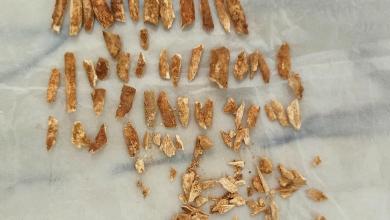FDA bans red dye from food, linked to cancer in rats

The U.S. Food and Drug Administration on Wednesday banned the use of red dye No. 3 in food, drinks and drugs, more than three decades after the synthetic pigment was first found to cause cancer in male lab rats.
The dye is a petroleum-based additive that has been used to give candies, sodas and other products a vibrant cherry-red hue. Consumer advocates say the agency’s decision to revoke the authorization was long overdue, given the agency’s 1990 decision to ban the chemical from use in cosmetics and topical drugs.
Under federal regulations, the FDA cannot approve food additives that cause cancer in humans or animals.
“This is great news and long overdue,” said Melanie Benesh, vice president of government affairs for the Environmental Working Group, one of several groups that petitioned the agency to take action on the additives. one of the organizations. “Red Dye 3 is the low-hanging fruit for toxic food dyes that the FDA should address.”
Starting in 2027, companies must start removing dyes from their products. Additives must also be removed from imported foods sold in the United States.
While the dye is still used in hundreds of products, many companies have begun turning to other food colorings, a move that came to a head in 2023 when California became the first state to ban Red 3, along with three other food additives linked to illness. Initiatives accelerated. The dye has also been linked to health problems in children.
In announcing the ban, the agency downplayed the risk to humans and said researchers had not found similar cancer risks in studies involving animals other than male mice. Jim Jones, the FDA’s deputy commissioner for human foods, said in a statement that available scientific information does not support the assertion that the use of red dye No. 3 in food and ingested drugs puts people at risk. .
Sarah Gallo, senior vice president of product policy and federal affairs at the Consumer Brands Association, a trade group, said food and beverage companies will comply with the agency’s decision. “Withdrawing the authorization for use of Red No. 3 is an example of the FDA using its risk- and science-based authority to review the safety of products on the market,” she said.
Red Dye No. 3 was first approved for use in food in 1907 and was banned from use in cosmetics by U.S. regulators in 1990. At the time, the FDA cited an industry-conducted study that found the chemical caused thyroid cancer in male rats, but estimated it could cause cancer in fewer than 1 in 100,000 people. In addition to banning dyes in cosmetics, the agency has pledged to do the same with food.
Europe, Australia and New Zealand have banned its use in food, with one notable exception: black cherries.
Although many food manufacturers have been using natural food colorings, including those derived from beets, red cabbage, and insects, Red Dye No. 3 is still found in many consumer products, such as corn candy, yellow rice, mashed potatoes, and children’s nutritional milk past. Consumers can learn whether products contain the dye through the USDA’s Branded Food Database and another database created by the Environmental Working Group.
Artificial dyes and food additives have been a major target of President-elect Donald J. Trump’s pick for health secretary, Robert F. Kennedy Jr., whose Senate confirmation hearings are about to begin.
While health and consumer advocates applauded the agency’s decision to ban red dye No. 3, they said decades of delays highlighted systemic flaws in federal regulation of food additives.
Thomas Galligan, chief scientist for food additives and supplements at the Center for Science in the Public Interest, said the agency’s failure to act sooner was partly due to industry opposition to the ban, but also reflected the FDA’s chronic underfunding of food safety.
“The FDA has a track record of allowing unsafe chemicals to persist in our food supply long after evidence of harm emerges,” he said. “Part of the problem is that the agency lacks a robust system. to reassess the safety of approved chemicals.”
He added, “Congress also bears a large share of the blame for failing to provide the FDA with the authority and resources it needs to protect public health.”
According to the organization, more than 200,000 pounds of Red 3 were used in food and medicine in 2021.
The FDA admits its regulatory work is flawed. Last year, the agency announced a restructuring of its human food program to more robustly address safety and health challenges in food and agriculture.
Brian Ronholm, director of food policy at Consumer Reports, which submitted a petition to the FDA last year calling for a ban on red dye No. 3, said dozens of other dyes remain in the U.S. food supply. Chemical food additives.
“Many synthetic food dyes are allowed for use in food, but for decades the U.S. Food and Drug Administration (FDA) has not classified these chemicals as safe, despite recent research linking them to serious health problems,” he said. “It’s time for the FDA to catch up with the latest science and remove these harmful chemicals from our food. “



